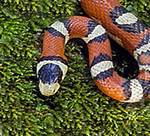 Believe it or not, snakes can be great to have around. After all, they love to eat rodents! But when they move onto our property, or even inside our homes, often something must be done. Here’s what you need to know when dealing with a possible Sonoran mountain kingsnake. A first step in snake control is to identify what kind of snake you have.
Believe it or not, snakes can be great to have around. After all, they love to eat rodents! But when they move onto our property, or even inside our homes, often something must be done. Here’s what you need to know when dealing with a possible Sonoran mountain kingsnake. A first step in snake control is to identify what kind of snake you have.
Color-wise, this is not a shy snake: it sports red, black, and white, cream, or yellow bands. Black bands border red. That’s how you know that they’re non-venomous: “Red touch yellow, hurt a fellow; red touch black, friend of Jack.” Light bands and become narrow or disappear on sides. Top of head black; snout light colored. The black bands on this snake follow a neat pattern: towards the middle of their back, the black bands get wider, almost touching, and narrowing towards the belly, forming a sort of diamond pattern.
Sonoran mountain kingsnakes are found in central Arizona south into Mexico; isolated populations are present in Utah and Nevada. It’s a protected species in Arizona.
It feeds on lizards, and presumably small rodents, in wooded or rocky areas near streams or springs. Since its diet includes rodents, its presence (within limits) is beneficial to humans; its diet also offers the best opportunity to control its population. In other words, if you have too many of these snakes around, controlling rodent populations is a very important step, along with possibly trapping and removal.
If you’re ever bitten by a Sonoran mountain kingsnake, make sure to get it checked out. Sonoran mountain kingsnakes are not venomous, but with any wild animal bite there’s a risk of infection.
Sonoran Mountain Kingsnake Control
There are several steps to dealing with snake problems: making your property less inviting to snakes, which includes making your property less inviting to the rodents they feed upon; and dealing with any snakes that are already there.
Habitat modification
In wooded, rural and riparian settings where snakes are common, their presence can be discouraged by eliminating stands of tall vegetation and removing piles of rock, lumber, and debris that might attract snakes to search for prey or shelter – especially close to buildings. Closing all entrances to rodent burrows make an area less attractive to snakes. It also helps greatly if one is persistent in controlling rats, mice, and field rodents in and around residences and other buildings.
Sonoran mountain king Snake Exclusion
- Structural gaps and crevices larger than 1/4 inch and within three feet of grade should be closed off; snakes can pass through very small openings.
- Screens on crawlspace vents should have mesh smaller than 1/4 inch.
- A thorough search should be made for cracks in the foundation, unscreened crawlspace vents, torn screens, and gaps around basement window frames.
- Check clearances under doors; seal any gaps with weatherstripping.
- Look for improper sealing where plumbing and utility lines penetrate the foundation of the building.
Checklist for Rodent Proofing Your Home
While we can’t guarantee that you’ll never have mice or rats in your home, taking these measures will reduce your risk of having rodents – and the snakes that feed on them – move into your home.
- Repair or replace damaged ventilation screen around the foundation and under eaves.
- Provide a tight fitting cover for the crawl space.
- Seal all openings around pipes, cables, and wires that enter through walls or the foundation.
- Be sure all windows that can be opened are screened and that the screens are in good condition.
- Cover all chimneys with a spark arrester.
- Make sure internal screens on roof and attic air vents are in good repair.
- Cover rooftop plumbing vent pipes in excess of 2 inches in diameter with screens over their tops.
- Make sure all exterior doors are tight fitting and weatherproofed at the bottom.
- Seal gaps beneath garage doors with a gasket or weatherstripping.
- Install self-closing exits or screening to clothes dryer vents to the outside.
- Remember that pet doors into the house or garage provide an easy entrance for rodents.
- Keep side doors to the garage closed, especially at night.
- Keep your trees trimmed, and your bushes and vines thinned. Make sure trees are trimmed back from the house at least 4 feet.
- Keep lids on garbage cans.
- Clean up all debris in the yard and storage areas.
- Seal around your attic.
- Don't leave pet food outside, especially at night.
- Pick your citrus as soon as it is ripe. Remove any fallen citrus from the ground.
- Store wood at least 18 inches above the ground and 12 inches away from walls.
- Eliminate standing water and fix leaky faucets.
Sonoran Mountain Kingsnake Removal
If you’re confident that you do indeed have a Sonoran mountain kingsnake in your house, and you want to deal with it yourself, try this: place a trashcan on the side of the snake, and use a broom or a similar tool to gently sweep it inside the trashcan. Relocate it well away from residential areas, and seal up any openings in your house where it can get back in.
If you have any doubt about which kind of snake you have, or if you suspect several, a call to a snake control company is warranted. A good snake control company will be able to help correctly identify your snakes, advise you on further steps to take to minimize the number of snakes that move onto your property and how to keep them out of your home, will be able to present you with trapping and removal options, will be knowledgeable of all local and state laws regarding the animals, and will carry all required licenses.
